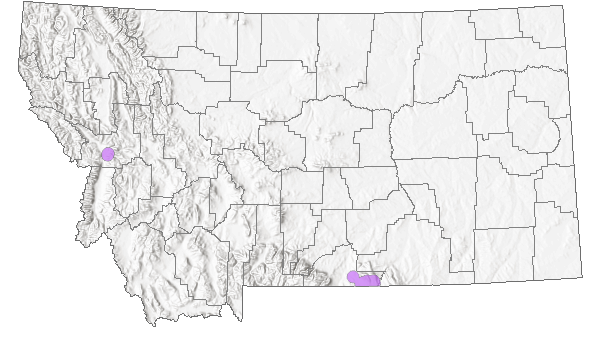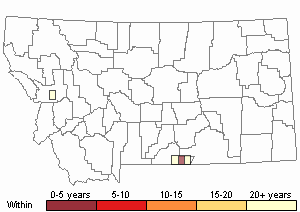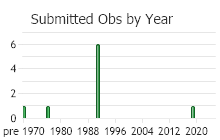View in other NatureServe Network Field Guides
NatureServe
Montana
Utah
Wyoming
Idaho
Wisconsin
British Columbia
South Carolina
Yukon
California
New York
Obscure Evening-primrose - Camissonia andina
Other Names:
Oenothera andina, Holmgrenia andina, Neoholmgrenia andina
State Rank Reason (see State Rank above)
This species is at the edge of its range in Montana, where it has been documented from just a few locations. All known extant locations are from Carbon County. These populations collectively cover less than 20 acres, but they can vary greatly in size from year to year. It tolerates grazing well, and moderate grazing may be important in maintaining a suitable seedbed of exposed soil. Invasive weeds may pose the greatest risk.
General Description
Obscure Evening-primrose is a small annual herb with stems, 3-15 cm high, that branch from the base and make the plant broader than it is tall. The strap-shaped leaves, 5-25 mm long, are clustered at the base of the plant and at the upper portions of the stems. Foliage is finely hairy. Tiny flowers are attached to the stem at the base of upper leaves. The 4 separate, yellow petals are 1-2 mm long, and the 4 sepals are reflexed. The stigma is ball-shaped. Petals and sepals are attached at the top of the ovary, which matures into a narrowly club-shaped capsule, 4-8 mm long, with the widest point attached to the stem.
Wagner et al. (2007, Syst. Bot. Monogr. Vol. 83; but see also Wagner & Hoch 2009 [Novon 19:130-132]) treat this as Neoholmgrenia andina (Nutt.) Wagner & Hoch.
Phenology
Flowering occurs in May and June.
Diagnostic Characteristics
Several other species of small evening-primroses occur in Montana. Oenothera scapoidea (=Cyclismia s.) has stalked fruits, O. minor (=Eremothera m.) has white flowers, and O. parvula has larger petals and a more open inflorescence.
Species Range
Montana Range
Range Descriptions

 Native
Native
Range Comments
BC, MT south to CA, NV, UT and WY (Lesica et al. 2012. Manual of Montana Vascular Plants. BRIT Press. Fort Worth, TX).
Observations in Montana Natural Heritage Program Database
Number of Observations: 9
(Click on the following maps and charts to see full sized version)
Map Help and Descriptions
Relative Density

Recency



 (Observations spanning multiple months or years are excluded from time charts)
(Observations spanning multiple months or years are excluded from time charts)
Habitat
Obscure evening-primrose is found in exposed sandy soil of dry prairie slopes, flats and depressions, in moist swales on south-facing hillsides, and in sagebrush (Kershaw et al. 2001). On the south side of the Pryor Mountains, where the majority of -- and all recently documented -- Montana populations are located, it occurs from 1220 to 1890 m (4000-6200 feet) in the foothills, with the shrubs Artemisia tridentata and Cercocarpus ledifolius, and occasionally in Douglas fir-Utah juniper woodland (Lesica and Achuff 1992).
National Vegetation Classification System Groups Associated with this Species
Forest and Woodland
Low Elevation - Xeric Forest and Woodland
Grassland
Lowland - Prairie Grassland
Sparse and Barren
Sparse and Barren
Ecology
Since this species is a small annual, it may benefit from moderate levels of disturbance (Lesica and Achuff 1992). Population sizes can vary greatly from year to year. Seeds may remain dormant during years with unfavorable growing conditions.
Management
This small evening-primrose can tolerate heavy grazing, and some disturbance from moderate grazing may be needed to provide a suitable seedbed of exposed soil (Kershaw et al. 2001). Invasive weeds pose a threat to at least one population.
Stewardship Responsibility
Threats or Limiting Factors
STATE THREAT SCORE REASON
Threat impact not assigned because threats are not known (MTNHP Threat Assessment 2021).
References
- Literature Cited AboveLegend:
 View Online Publication
View Online Publication Lesica, P., M.T. Lavin, and P.F. Stickney. 2012. Manual of Montana Vascular Plants. Fort Worth, TX: BRIT Press. viii + 771 p.
Lesica, P., M.T. Lavin, and P.F. Stickney. 2012. Manual of Montana Vascular Plants. Fort Worth, TX: BRIT Press. viii + 771 p. MTNHP Threat Assessment. 2021. State Threat Score Assignment and Assessment of Reported Threats from 2006 to 2021 for State-listed Vascular Plants. Botany Program, Montana Natural Heritage Program, Helena, Montana.
MTNHP Threat Assessment. 2021. State Threat Score Assignment and Assessment of Reported Threats from 2006 to 2021 for State-listed Vascular Plants. Botany Program, Montana Natural Heritage Program, Helena, Montana.
- Additional ReferencesLegend:
 View Online Publication
View Online Publication
Do you know of a citation we're missing? Kershaw, L., J. Gould, D. Johnson & J. Lancaster. 2001. Rare vascular plants of Alberta. University of Alberta Press, Edmonton, Alberta, Canada. 484 pages.
Kershaw, L., J. Gould, D. Johnson & J. Lancaster. 2001. Rare vascular plants of Alberta. University of Alberta Press, Edmonton, Alberta, Canada. 484 pages. Lesica, P. and P.L. Achuff. 1992. Distribution of vascular plant species of special concern and limited distribution in the Pryor Mountain desert, Carbon County, Montana. Unpublished report to the Bureau of Land Management. Montana Natural Heritage Program, Helena, MT. 105 pp.
Lesica, P. and P.L. Achuff. 1992. Distribution of vascular plant species of special concern and limited distribution in the Pryor Mountain desert, Carbon County, Montana. Unpublished report to the Bureau of Land Management. Montana Natural Heritage Program, Helena, MT. 105 pp. Lesica, P., M.T. Lavin, and P.F. Stickney. 2022. Manual of Montana Vascular Plants, Second Edition. Fort Worth, TX: BRIT Press. viii + 779 p.
Lesica, P., M.T. Lavin, and P.F. Stickney. 2022. Manual of Montana Vascular Plants, Second Edition. Fort Worth, TX: BRIT Press. viii + 779 p. Quire, R.L. 2013. The sagebrush steppe of Montana and southeastern Idaho shows evidence of high native plant diversity, stability, and resistance to the detrimental effects of nonnative plant species. M.Sc. Thesis. Bozeman, MT: Montana State University. 124 p.
Quire, R.L. 2013. The sagebrush steppe of Montana and southeastern Idaho shows evidence of high native plant diversity, stability, and resistance to the detrimental effects of nonnative plant species. M.Sc. Thesis. Bozeman, MT: Montana State University. 124 p.
- Web Search Engines for Articles on "Obscure Evening-primrose"





